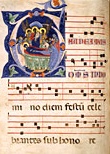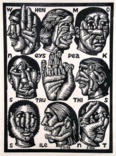
text - The
main body of words in a book, magazine,
pamphlet, or other printed or electronic publication, or in any
work of art. Also, the body
of writing about a topic.
Marks are sometimes differentiated only as forming either graphical or textual imagery.
What has been written or said about an artwork or topic is sometimes referred to as its text, and can even be considered to include whatever might theoretically be written or said about it.
Examples of works which either contain or refer to text:

Mesopotamia, Uruk, Document
Consisting of Ideograms, late 4th-early 3rd millennium
BCE,
stone, 4.3 x 2.3 cm, Hermitage
Museum, St. Petersburg, Russia. See Mesopotamian art.

Gerona Bible Master, Bologna, Italy, Gradual,
Proper and Common of Saints (folio
84 verso in Manuscript
526), c. 1285, tempera on vellum,
one of 290 folios, 51.5
x 35.5 cm (20 1/4 x 14 inches), Musei Civici d'Arte Antica, Bologna.
Black marks arranged on the horizontal
lines ("staff")
displayed here exemplify the system of musical
notation used in Italy during much of the Middle
Ages. The Latin text (or lyric) opens with "Gaudeamus,"
meaning "Let us rejoice." The initial letter "G" is historiated in late
Byzantine
style. This "gradual" is one of a set of three that together comprise the sung portions
of the Mass for the entire church year.

Count de Meurs, (Netherlandish), Drawings in a Letter, early 1500s, Library
of Zutphen, Netherlands. Manuscripts dating back to the Middle Ages often used sequential
pictures accompanied by text, or sometimes even used text-balloons
for captions as in this example. See cartoon and Dutch
art.

Germany/Switzerland, upper Rhenish (Strasbourg),
The Queen of Sheba before King Solomon,
1490-1500, tapestry
with linen warp,
wool, linen, and metallic wefts,
31 x 40 inches (80 x 101.6 cm), Metropolitan Museum of Art, NY.
This tapestry depicts the biblical story (1 Kings 10:1-3) about
the Queen of Sheba standing before King Solomon and posing a
riddle. Employing a device in which text appears in floating
ribbons, the tapestry designer has the Queen asking, "Tell
me, King, whether the flowers and children are of the same or
different kind." Solomon replies, "The bee does not
pass up a good flower; kneeling shows the female style." This depiction echos the compositions
of some late-fifteenth-century prints.

Charles Demuth (American, 1883-1935), The Figure 5 in Gold, 1928, oil
on cardboard, 35 1/2 x 30 inches (90.2 x 76.2 cm), Metropolitan
Museum of Art, NY. In the 1920's Demuth produced a series of
poster-portraits
honoring his contemporaries,
inspired by Gertrude Stein's word-portraits. The Figure 5
in Gold is the most accomplished of the group. It was dedicated
to the artist's friend William Carlos Williams, the American
poet whose "The Great Figure" inspired the painting's title and imagery. Demuth's
painting, however, is not a representational
illustration
of the poem but rather an abstract
impression of the No. 5
fire engine clanging through the lamp-lit streets of the darkened,
rainy city. Scattered words and initials refer to the artist
and the poet. See auditory,
emphasis, Futurism, and text.

Robert
Indiana (born Robert Clark, American, 1928-), LOVE, 1966, oil
on canvas, 71 7/8 x 71
7/8 inches, Indianapolis Museum of Art, IN. See Pop Art.

Peter Gourfain (American, 1934-), Hen Eys Tru Ile, 1993, linoleum cut on handmade paper. Peter Gourfain is fascinated by language and has developed his own alphabet (used here in his signature), and many of his works incorporate palindromes -- words or phrases that read the same backward as forward. The title of this work is culled from the apparently random vertical sorting of one column of letters, which, when read in normal sequence offer the aphorism,“When money speaks truth is silent.” The four corner heads are inhabited by another sort of text: signing hands that spell out F-E-A-R.

Ed Ruscha (American, 1937-), Purely Polyester, 1977, pastel on paper,
23 x 29 inches, Kemper Museum of Contemporary Art, Kansas City,
MO.

Ed Ruscha, Scratches on the Film, 1993, acrylic on canvas, 36 1/16 x 72 inches (91.6 x 182.9 cm), North Carolina Art Museum, Raleigh.

Dennis Oppenheim (American, 1938-), Salt Flat, 1968, photograph, map and typewritten text on cardboard,
28 x 22 inches (71.1 x 55.9 cm), Tate Gallery, London. This work
is the documentation of
an earth art
activity that Oppenheim carried out in New York on 28 November
1968 when he spread 1000 pounds of finely granulated baker's
salt on a vacant asphalt parking lot in a rectangle
50 x 100 feet. It comprises a map of Manhattan on which the site
is marked with a cross and a circle,
a color photograph of the salt in position, with the artist standing
beside it, and an explanatory text. The text reads:
SALT FLAT 1968
Location: (part 1) 6th Avenue and 25th Street New York City
1000 pounds of bakers salt 50' x 100' on asphalt surface. Identical
dimensions are to be transferred in 1' x 1' x 2' salt lick blocks
to ocean floor off Bahama coast xx and dug to a 1' depth - Salt
Lake Desert, Utah.
Bruce
Nauman (American, 1941-), Window, 1967, neon with glass
tubing suspension frame, 59 x 55 x 2 inches (149.9 x 137.7 x
5.1 cm), private collection. See aphorism.
Martha Rosler (American, 1943-), The Bowery in two inadequate descriptive systems, 1974-75, series of 45 gelatin silver prints of text and images on 24 backing boards, 11 3/16 x 23 5/8 inches (28.4 x 60 cm), Whitney Museum of American Art, NY. Responding to a century-long history of photographing the alcoholism-plagued inhabitants of New York's rundown Bowery neighborhood Rosler juxtaposed photographs of vacant Bowery storefronts with photographs of all the alcohol-related words she could think of. The absence of drunken men and the use of text set her piece apart from earlier photographic depictions of the Bowery. The combination of documentary photography and language suggests the shortcomings of both of these "descriptive systems" to fully address the complex political and social conditions that exist in the Bowery. See photography.

Joseph Kosuth (American, 1945-), Clock (One and Five), English / Latin
version, 1965, clock, photograph
and printed texts on paper,
unique, 61.0 x 290.2 cm,
Tate Gallery, London. See conceptual
art, horology, and
time.
Jenny Holzer (American, 1950-), Selection from Laments, 1989, 3 Nubian black granite sarcophagi and L.E.D. electronic display signboards, 82 x 30 x 24 3/8 inches (208.2 x 76.2 x 61.9 cm) each, collection of Ms. Thea Westreich and Mr. Ethan Wagner.
Wim Delvoye (Belgian, contemporary), four
pieces:
SUE, IN BAR ROUND CORNER SEE YOU THERE. A.
MUM, KEYS ARE YOU KNOW WHERE
DAVID, JUST POPPED OUT FOR A MOMENT, BACK IN TEN MINS.
TIME TO GO. CATCH YOU LATER, A.
photographs
altered so that texts appear to have been carved
into living rock, published
in the printed and web-based art periodical TRANS> arts.cultures.media, Vol.1/2,
No.3/4, 1997.

Glenn Ligon (American, 1960-), Untitled: Four Etchings, 1992, four softground
etching,
aquatint, spit bite
and sugarlifts on paper, 25 x 17
1/4 inches each, Broad Art Foundation, Santa Monica, CA. See African American art.
Also see aphorism, brainstorming, broadside, brochure, conceptual art, copy, cuneiform, font, glyph, graphic design, handbill, hieroglyphics, icon, iconomatic, ideogram, incunabulum, intertextuality, letterform, lettering, logo, narrative art, nomenclator, petroglyph, pictograph, placeholder, reflexivity, title, typography, and World Wide Web (WWW).

https://inform.quest/_art